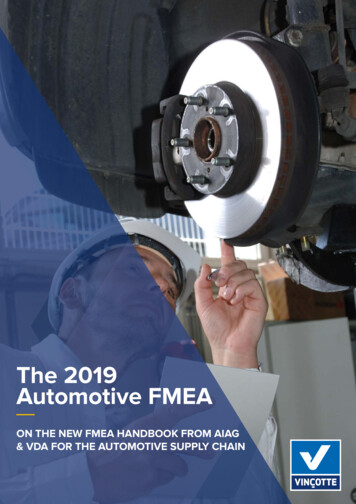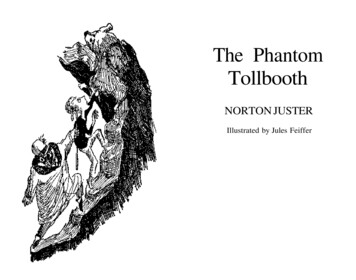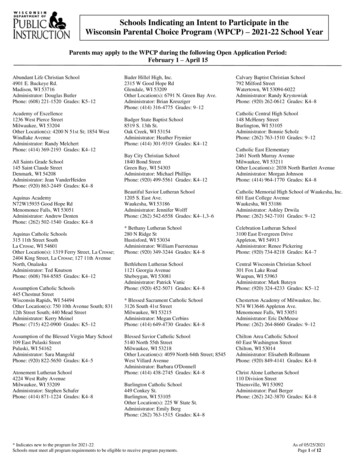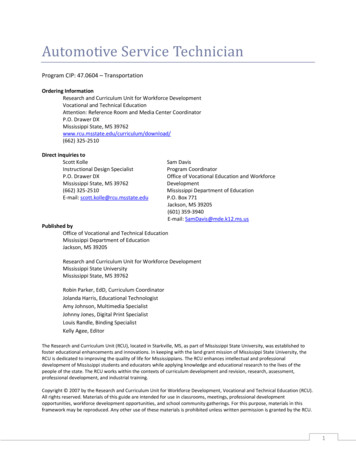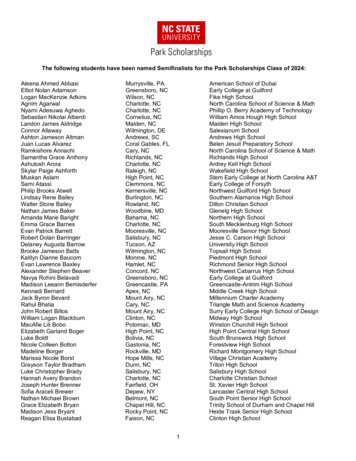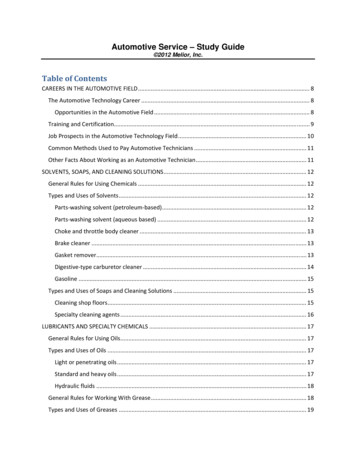
Transcription
Automotive Service – Study Guide 2012 Melior, Inc.Table of ContentsCAREERS IN THE AUTOMOTIVE FIELD . 8The Automotive Technology Career . 8Opportunities in the Automotive Field . 8Training and Certification. 9Job Prospects in the Automotive Technology Field . 10Common Methods Used to Pay Automotive Technicians . 11Other Facts About Working as an Automotive Technician . 11SOLVENTS, SOAPS, AND CLEANING SOLUTIONS . 12General Rules for Using Chemicals . 12Types and Uses of Solvents . 12Parts‐washing solvent (petroleum‐based) . 12Parts‐washing solvent (aqueous based) . 12Choke and throttle body cleaner . 13Brake cleaner . 13Gasket remover. 13Digestive‐type carburetor cleaner . 14Gasoline . 15Types and Uses of Soaps and Cleaning Solutions . 15Cleaning shop floors. 15Specialty cleaning agents . 16LUBRICANTS AND SPECIALTY CHEMICALS . 17General Rules for Using Oils. 17Types and Uses of Oils . 17Light or penetrating oils . 17Standard and heavy oils . 17Hydraulic fluids . 18General Rules for Working With Grease . 18Types and Uses of Greases . 19
Types and Uses of Specialty Additives . 19Types and Uses of Specialty Chemicals . 20Locking and antiseize compounds . 21TYPES OF WRENCHES . 22Metric and U.S. Customary System (USCS) Wrenches. 22Common Wrenches . 23Socket Wrenches . 25Other Wrenches . 29TYPES OF SCREWDRIVERS AND PLIERS . 31Screwdrivers. 31Pliers. 33TYPES OF HAMMERS, PUNCHES, AND CHISELS . 36Hammers . 36Safety . 37Punches . 38Chisels . 39SPECIALTY TOOLS . 41Special Cutting Tools . 41Electrical System Tools . 43Lubrication Specialty Tools . 47Miscellaneous Specialty Tools . 48FASTENERS . 49Common Vehicle Fasteners . 49Nuts and bolts in the U.S. Customary System (USCS) . 49Nuts and bolts in the metric system . 51Washers . 51Types of screws . 52Studs. 53Snap rings . 53Rivets . 54Adhesives . 54Cutting Threads, Repairing Threads, and Removing Broken Bolts . 55
Types of taps . 55General procedure for using a tap . 55Using a die to cut threads onto a rod . 56General procedure for using a die . 56Procedures for repairing damaged or stripped threads . 57Procedures for removing a bolt that is broken off in a threaded hole because of overtightening . 57MEASURING TOOLS. 58Types and Uses of Common Measuring Tools . 58Procedures for the Use and Care of Measuring Tools . 60Using an outside micrometer. 60Using a dial indicator. 61Using a feeler gauge . 61Using a dial caliper . 62Using Plastigage . 62Care of measuring tools . 62POWER TOOLS . 63Principles of Using Power Tools . 63Electric tools . 63Pneumatic tools . 64Basic designs of pneumatic tools . 65Pneumatic couplings . 65Cordless tools . 65Hydraulic tools . 65Power Drills . 66Drill bits . 67Power Wrenches . 68Impact wrench . 68Using impact wrenches . 69Air ratchet . 69Air chisel (air hammer). 70Miscellaneous Power Tools. 71Heat gun . 71
Mini die grinder. 72Blowgun . 72SHOP EQUIPMENT . 73Electrical Equipment . 73Wheel balancer . 73Bench grinder . 74Drill press . 75Test and service equipment . 76Pneumatic Equipment. 76Tire machine . 77Pneumatic jack . 78General maintenance guidelines for pneumatic equipment . 79Hydraulic Equipment. 79Hydraulic floor jack . 79Hydraulic lift . 80Hydraulic press . 80Engine hoist . 81Vehicle Service Information . 83Sources . 83Formats . 83Using the Manufacturer's Service Information. 84Locating and Reading the Vehicle Codes . 85CUSTOMER SERVICE, WORK ORDERS, AND VEHICLE PREPARATION. 86Proper Customer Relation Procedures . 86Preparing a Vehicle Before and After Service . 87Functions and Components of a Work Order . 89Diagnosing a Vehicle Problem . 90BRAKE SYSTEM FUNDAMENTALS . 92Principles of Friction . 92Heat and Brake Linings. 93Weight and Speed . 94Friction Between Tire and Road. 95
Service Brakes & Parking Brakes . 95Base Brake Components . 96Brake Subsystems . 96Hydraulic Principles . 97Split Hydraulic Systems . 99Diagonal Split Hydraulic System. 99Front/Rear Split Hydraulic System . 100Regenerative Braking . 100ELECTRICAL FUNDAMENTALS . 101Electrical Properties . 101Voltage . 101Current . 101DC and AC. 102Resistance . 102Shorts and Opens . 103Voltage Drop . 103Battery and Starting/Charging System Test Equipment . 104AUTOMOTIVE BATTERIES . 105Battery Function . 105Battery Construction . 106Low Maintenance and Maintenance Free Batteries . 107Gel Cell and Absorbent Glass Mat (AGM) Batteries . 108Electrolyte and Specific Gravity . 109Chemical Reactions while Discharging and Charging. 109Battery Safety. 110Battery Temperature and Efficiency . 112Battery Ratings . 114Cold Cranking Amps (CCA) . 114Cranking Amps (CA) . 114Reserve Capacity (RC) . 114Ampere‐Hour Rating (AH) . 114BATTERY CHARGE AND TESTING . 115
How Batteries Lose Power . 115Normal Aging . 115Overcharging . 115Undercharging and the Result: A Sulfated Battery . 116Parasitic Loads. 116Phantom Drains . 118Self‐Discharging. 119Inoperative or Missing Hold‐Down . 119Corrosion . 119Battery Testing and Service . 121Initial Assessment . 121Open Circuit Voltage . 122Hydrometer Testing . 123Built‐In Hydrometers . 123Conventional Hydrometers . 124ENGINE OVERVIEW . 128Basic Engine Parts and Operation . 128Engine Block . 128Cylinders. 130Pistons . 130Piston Rings . 131Connecting Rods . 131Crankshaft . 132Cylinder Head . 133Valve Train . 134The Four‐Stroke Cycle (Otto Cycle) . 135Other Engine Designs . 137Two‐Stroke Cycle Engines . 137Diesel Engines . 141Rotary Engines . 143Engine Classifications . 144Number and Arrangement of Cylinders . 144
Displacement . 147Number of Valves and Valve Train Type . 148Pushrod Engines . 149Fuel Type . 149Cooling System Type . 149
CAREERS IN THE AUTOMOTIVE FIELDThe Automotive Technology CareerOpportunities in the Automotive FieldAccording to statistics from the U.S. Department of Labor, over 800,000 people in the United Statesare employed as automotive service technicians and mechanics. Most are employed in the followingbusinesses: Automotive repair and maintenance shopsAutomobile dealersRetailers and wholesalers of automotive parts, accessories, and suppliesOthers work in the following businesses or organizations: Gas stationsHome and automotive supply storesAutomotive equipment rental and leasing companiesFederal, state, and local governmentsOver 16% own their own business.Many job opportunities are available that relate directly and indirectly to the automotive technologyfield.
Opportunities directly related to automotive technology: Automotive technicianAutomotive technician's apprenticeRepair shop supervisorExhaust and emissions technicianTune-up technicianService writerMechanical unit repairerTechnician in automotive manufacturing plantsAir conditioning technicianEngine technicianDiesel technicianBus inspectorTractor technicianParts salvagerTeacher or trainerNote: Many graduates of automotive technology programs qualify to pursue a career as a teacher ortrainer with little or no extra training required for an entry-level position.Opportunities indirectly related to automotive technology: Farm equipment technicianAircraft technicianOffice equipment service technician/service representativeMachinist apprenticeAir conditioning and heating service apprenticeIndustrial machine maintenance technicianSmall engine technicianMarine equipment technicianMotorcycle technicianTraining and CertificationRepairing and maintaining today's sophisticated
Technicians refer to these as "book hours." The technician is paid this flat rate regardless of the time spent on a job. Hourly plus a percentage of labor and parts Other Facts About Working as an Automotive Technician Automotive technicians use many different to


